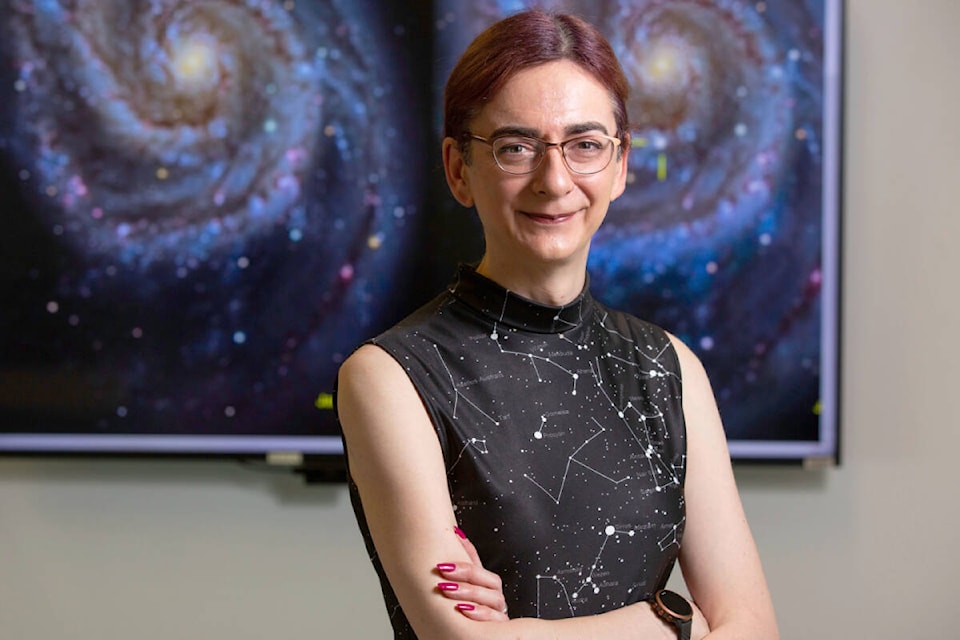COVID-19 forced the Nanaimo Astronomy Society to switch to virtual meetings, but the silver lining of that cloud is that the club can now attract experts from around the world to speak at those meetings.
Astrophysicist Jan Jamie Eldridge, head of the University of Auckland University department of physics, will tell how the lives and deaths of stars create elements fundamental to the existence of life in her presentation ‘We are All Made of Stardust’ at the astronomy society’s meeting this week.
Eldridge’s general research focuses on the lives and deaths of stars in the Milky Way galaxy and in galaxies at the edge of the observable universe.
She says different types of stars produce different elements and single stars will produce different elements than if they are in binary star systems.
“Our sun is currently fusing the element hydrogen to the element helium in its core,” Eldridge said in an e-mail. “Eventually the core will be all helium, then our sun will be able to fuse this into carbon and oxygen. From this point no further nuclear fusion is possible in the core, but it is surrounded by burning shells that are still making carbon.”
Those burning shells making the carbon and oxygen are closer to the star’s surface and can be thrown into the galaxy to eventually make up new stars.
“Eventually, though, the carbon-oxygen core is exposed and becomes a star remnant/corpse we call a white dwarf, which just slowly cools down with no more fusion reactions,” she said.
If the sun were in a binary pair, it could become a white dwarf star if its companion star draws away all of its hydrogen. That stops some elements from being made, but opens the door for creation of others through a different process. The hydrogen-thieving companion star could expand to the point where the white dwarf starts stealing back its hydrogen until it reaches a specific mass and explodes, turning all its stored carbon and oxygen into iron.
“So the short story is, binaries can prevent evolution of what we expect a star to have, changing the conditions deep in the star where nuclear fusion occurs,” Eldridge said. “This can both prevent elements from being created but also lead to new pathways that can only occur in a binary star system.”
Scientists’ understanding of the source of elements such as gold, silver and platinum changed in 2017 when they witnessed the collision of two neutron stars – remnants of extremely massive stars left with cores of just neutrons after their fusion material was expended – which produced gravitational waves, but also visible light that allowed astronomers to calculate what elements were created.
“These events are really rare,” Eldridge said. “To form one neutron star you need to completely blow up a whole star in a supernova. To get a binary neutron star you need to blow up two stars and hope the two neutron star remnants stay orbiting each other. One of the reasons why different elements are less or more abundant all tracks back to how many types of different stars make them.”
Star evolution also accounts for why the abundance of different elements has not been constant throughout the age of the universe.
“Oxygen and carbon, for instance, are produced in large quantities in the early universe as single stars dying make those elements quite quickly, but for iron and gold the binary systems can take a lot longer to make elements so there is a long delay before the universe becomes more enriched in iron and gold compared to oxygen,” Eldridge said. “The evidence for this is that we can see that older stars, formed longer ago, are metal-poor and oxygen-rich, compared to what we see in the Earth and our sun.”
Nanaimo Astronomy Society’s next monthly online meeting happens Thursday, March 24, at 7 p.m. Non-members are welcome to attend one meeting for free. To learn more about the society, how to attend a meeting or to become a member, visit www.nanaimoastronomy.com.
READ ALSO: Nanaimo Astronomy Society speaker will shed light on photographing the northern lights
photos@nanaimobulletin.com
Like us on Facebook and follow us on Twitter
